Guest Post by William O’Neill
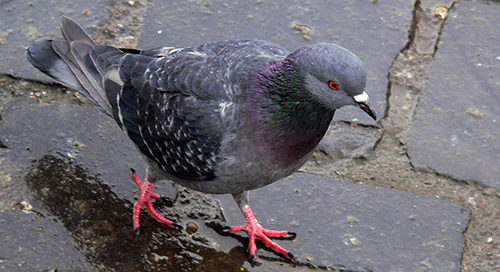
A pigeon going about the daily routine.
There are over three hundred species of pigeons and doves! The most ubiquitous member of their family is Columba livia– the Rock Pigeon. You most likely refer to them simply as pigeon. They’re the enigmatic little citizens you pass by on a daily basis. Pigeons are commonly associated with cities, and often referred to as cosmopolitan species or urban wildlife. Their affinity for our cities is no fluke. Humans domesticated pigeons, at least five thousand years ago. They originated in North Africa, Southern Europe and Western Asia. They can now be found in urban areas on most continents, following human introduction. In the wild, pigeons prefer to nest and roost in the nooks and crannies of cliff faces and other protective, rocky areas. Our buildings act as the perfect surrogate. Their relationship with humans has shown to be quite beneficial for the species, with current global populations estimated to be two hundred and sixty million (still far short of the global human population). However, their success and intimate relationship with human civilization has resulted in the attribution of some onerous and undeserved reputations for being dirty, diseased, native-bird displacers. Nothing could be further from the truth. Pigeons are intelligent, emotional, loyal and amazing animals.

There are many housing options for this discerning tenant.
More than half of the world’s population lives in urban environments (UN, 2014), so it is no surprise that any one person’s daily routine comes with a shortage of wildlife interactions. Depending on where you live, urban wildlife may consist of dogs, cats, raccoons, rats, coyotes and birds. Surprisingly, twenty percent of the approximately ten thousand bird species on the planet live in cities (Aronson MFJ et al, 2014). Among those, the most cosmopolitan and readily identified is the pigeon. Many people don’t give pigeons the time of day, unless they happen to be “in their way” on the sidewalk. Taking a closer look at our avian neighbors would reveal their interesting and endearing lives. On any given day, you can observe pigeons: courting their life-long mates; gathering materials to build their nests where they will raise many generations of children; maneuvering through the air to avoid predators; engaging in social interactions and much more! Like you and I, pigeons are just trying to get by in the world the best they can. Taking notice of their lives can be extremely enriching to our own.
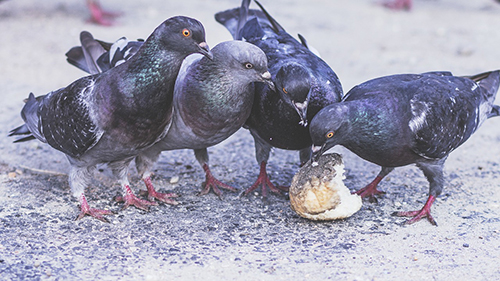
Some colleagues grab a bite to eat.
Non-native species get a pretty bad rap for destroying ecosystems and displacing native species. This is not true of all non-natives. Pigeons are one of the many introduced species that has been incorrectly labeled as a usurper of native bird’s habitat. As previously stated, pigeons do so well because they make use of the vastly altered landscapes produced by humans. Pigeons now occur in eighty percent of cities globally (Aronson MFJ et al, 2014). This might lead you to believe they have a great effect on the native bird populations. This is not the case. In cities, non-native bird species, including pigeons, account for less than five percent of the bird population. The observed dearth of native bird species is a result of anthropogenic forces (Aronson MFJ et al, 2014). It is the alteration of habitat to urban use by humans, which poses a strong threat to native birds.
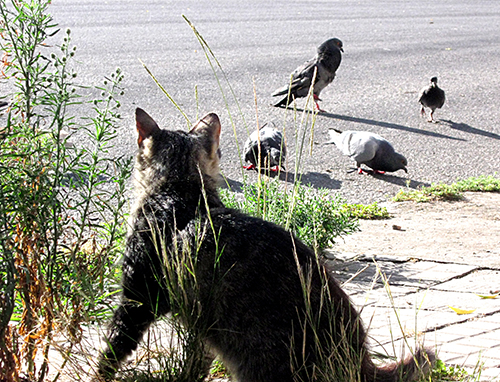
Even while courting a mate, pigeons must be vigilant
Despite some commonly held stereotypes, generally speaking, animals do not enjoy being dirty and take steps to ensure their cleanliness. Pigeons are no exception. In fact, birds are fastidious in their hygiene, due to the importance of keeping their feathers in good shape. Bird feathers serve many functions such as flying, keeping the individual warm or cool, and employment in mating displays. Birds have devised a number of methods for feather upkeep. Birds preen by using their beak to straighten out their feathers. Each feather has smaller parts called barbs, which can become tangled and askew. Birds use their beaks much like a human might use a brush or comb. Birds also take sunbathes, ant baths, bathe in water, and preen socially. So, when you see a pigeon out on the street and they aren’t looking their best, it isn’t for lack of effort. As it turns out, humans and our cities aren’t the cleanest. With all the time it takes city pigeons to find their food; dodge cars, buses and bikes; avoid human foot traffic; and elude predators, access to clean water and time to preen can be scarce. This is compounded by the amount of waste and pollution humans spread about.
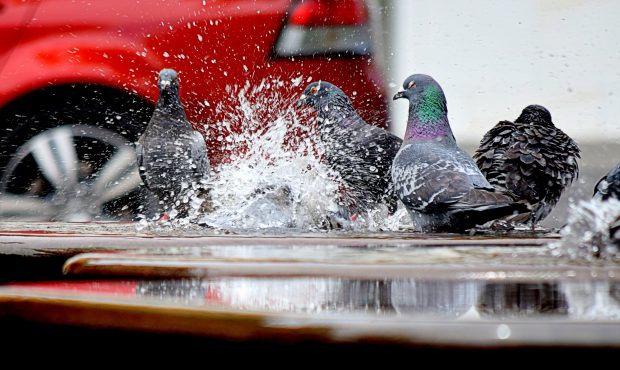
Pigeons trying to keep clean in the seedy city.
As a great person once did not actually say, “I cannot tell a lie”. Pigeons, like all animals (including humans) carry disease. However, the risk to humans has been inflated, possibly as a precaution (possibly for monetary gain), with negative consequences for pigeons. From 1941 through 2003, there were only 176 cases of transmission from feral pigeons to humans (Haag-Wackernagel, 2004). Pigeons have been shown to harbor sixty to seventy human pathogens, but only seven have been transmitted to humans (Haag-Wackernagel, 2004). The most likely method for transmission is through respiration. This is because the pathogens most often implicated are breathed in with old, dry droppings. The majority of people affected are workers cleaning up droppings and people with compromised immune systems. Acquiring these pathogens can be easily avoided by taking proper precautions. Workers in close contact with droppings can wear masks to prevent inhalation. Persons with compromised immune systems can avoid encounters with pigeons and their droppings. As is often the case, prevention works.
If anyone has ever called you a bird-brain, I hope your response was, “Thank you very much!” Birds are among the smartest members of the animal kingdom. Most of the recognition goes to the Corvids: crows, ravens and jays. If Corvids are the Einsteins of the bird world, then pigeons are the Teslas. Numerous research has been done into the intelligence and abilities of pigeons. They have solved the old “box and the banana” test (Steinissen, 2010). A treat is suspended just out of the pigeon’s reach and a box is placed in the room, but away from the treat. The pigeon successfully figures out how to use the box to gain the necessary height to obtain the treat. Pigeons have been shown to have self-recognition on par with that of three-year old humans. They are able to view two video feeds and determine which video is of them and which is a recording of another pigeon (Keio University, 2008). Pigeons are also capable of discerning between two sets of objects based on their characteristics and selecting them accordingly (University of Iowa, 2014).
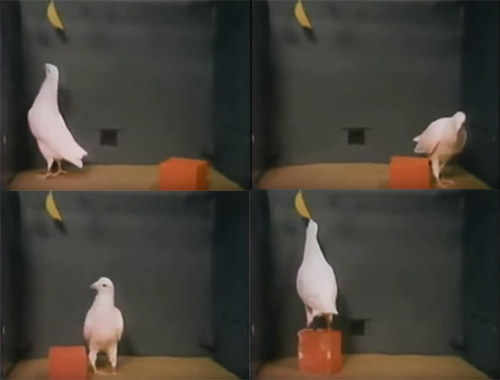
These images taken from video of the Banana-box experiment show the subject figuring out to move the box to obtain the banana.
A well-known behavior of pigeons is their homing ability. Humans have taken advantage of it for thousands of years, in different ways. Humans drive pigeons away from their homes and “race” the pigeons to see who gets home first (this is a major no-no as many do not make it back at all). Pigeons have also served in the armed forces as messengers, often rescuing humans from death and earning medals in the process (see Cher Ami). Pigeons accomplish these amazing feats in multiple ways. Studies on pigeon homing abilities have shown that the birds possess a compass that relies on both the sun and the Earth’s magnetic field. When the sun is obscured, they switch to using the magnetic field and vice versa. They also employ landmarks. Pigeons use rivers, roads, buildings and other features as paths and markers in their own mental map (BBC Earth, 2014). Pigeons are real home bodies, so it is no wonder they have developed all of these extraordinary skills for finding their way there.
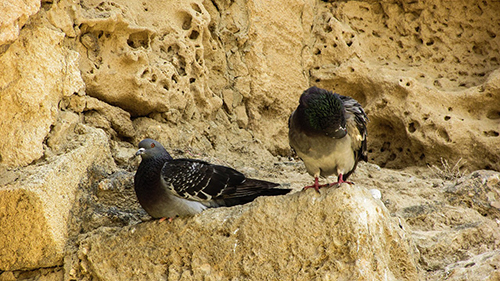
Pigeons enjoying their native habitat.
The reason pigeons are so inclined to get back to their home is that they likely have a family waiting for them. Pigeons mate for life. Once the courtship is complete, the pair locates a nesting site. There, the male will retrieve the materials and the female will design and construct the nest (and sometimes reverse roles). Typically, pigeons will lay two eggs at a time. Both parents feed the young by producing a substance in their crop, commonly referred to as “milk”. This is the reason that pigeons grow up so fast. The mated pair will stay together and reuse the same home they have built for many generations, rebuilding it stronger each time. Unfortunately, the city life takes it toll on them and many pigeons live short lives of three to four years. Pigeons, like many birds, mourn their deceased. These intelligent and emotional beings lead full and incredible lives.
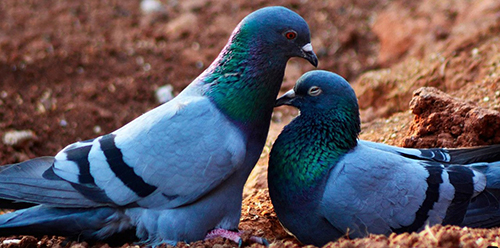
A mated pair show affection.
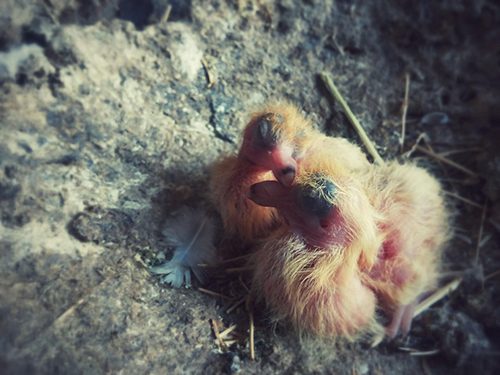
Two pigeon babies.
It is no wonder that with all of these qualities, pigeons make great companions for us humans. Wild pigeons should be just that: wild. But, many pigeons are bred and raised as domestic for various purposes. These individuals will find it hard to survive in the wild, if they ever get there. If they are able to escape their fate (often as food or racers), and lucky enough to be rescued, they will make themselves right at home in ours. Just like the more common companions-cats and dogs-they are loyal and endearing.
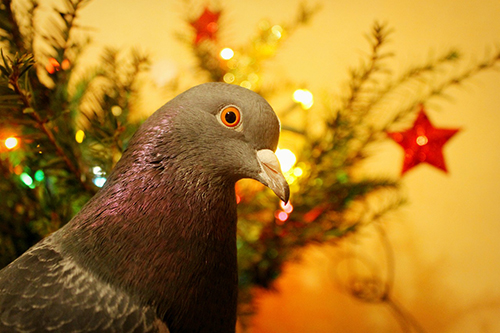
Christmas made merrier by a pigeon companion.
On your way to work or school in the morning, you might cross paths with some pigeons just starting their day as well. We will all be navigating the same crowded city streets through out our day. While we sit in a restaurant eating our meals and staring out the window, you’ll probably see some pigeons pecking about the ground, doing the same. When you drive home from the store with supplies for your next home improvement project, you may notice a pigeon cruise by with some new materials for their nest. The next time you encounter a pair of pigeons walking side by side and never straying too far from each other, perhaps you’ll wonder, “How long have they been together?” These intriguing little lives are all around us. If we take the time to notice them, ours just might be a little better.

William O’Neill grew up in Santa Rosa, CA and now lives in San Francisco, CA with his wife, dog and cat. He obtained his Bachelor of Science Degree in Zoology from San Francisco State University. There he researched climate change and Lyme disease ecology. He enjoys walking his dog Squirrel, relaxing with his cat Lola, observing the pigeons at 22nd Ave and Irving Street, and volunteering with Palomacy. His answer to “What is your favorite…” will always be Jurassic Park.
References
Title “Home along the lanes of the skyway” lyric from Elton John’s “Skyline Pigeon”
Aronson MFJ et al. 2014 A global analysis of the impacts of urbanization on bird and plant diversity reveals key anthropogenic drivers. Proc. R. Soc. B 281: 20133330.
BBC Earth, 2014. How do homing pigeons get home? – Extraordinary Animals – Series 2 – Earth. https://www.youtube.com/watch?v=Wl0Ii29XmNk
Haag-Wackernagel D, Moch H. 2004. Health hazards posed by feral pigeons. J Infect. 2004 May;48(4):307-13
Keio University. (2008, June 14). Pigeons Show Superior Self-recognition Abilities To Three Year Old Humans. ScienceDaily. Retrieved October 12, 2016 from www.sciencedaily.com/releases/2008/06/080613145535.html
Steinissen, Geert. 2010. Insight learning: Pigeon Solves the Classic Box-and-Banana Problem. https://www.youtube.com/watch?v=XtHYyfDdSUg
United Nations 2014. World’s population increasingly urban with more than half living in urban areas.
http://www.un.org/en/development/desa/news/population/world-urbanization-prospects-2014.html
University of Iowa. (2014, April 2). Pigeons share our ability to place everyday things in categories. ScienceDaily. Retrieved October 12, 2016 from www.sciencedaily.com/releases/2014/04/140402095107.html

